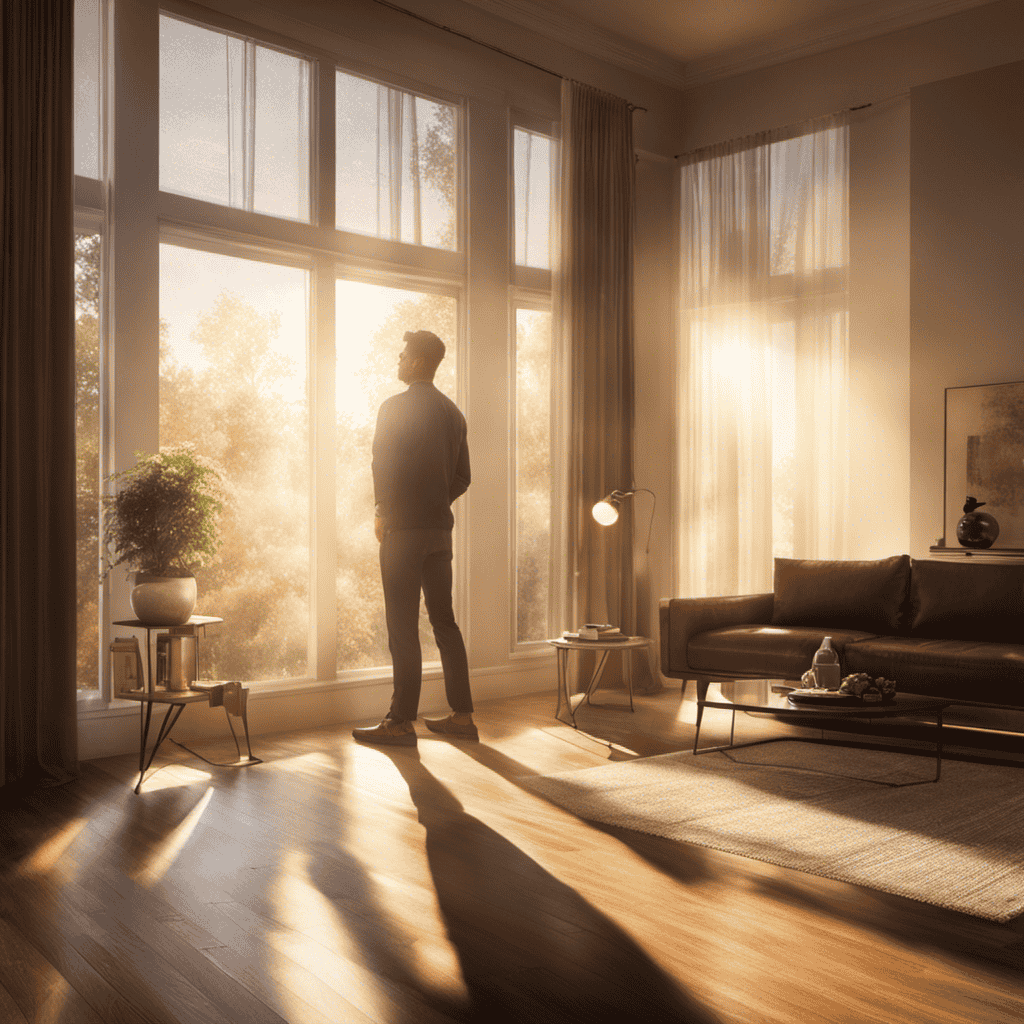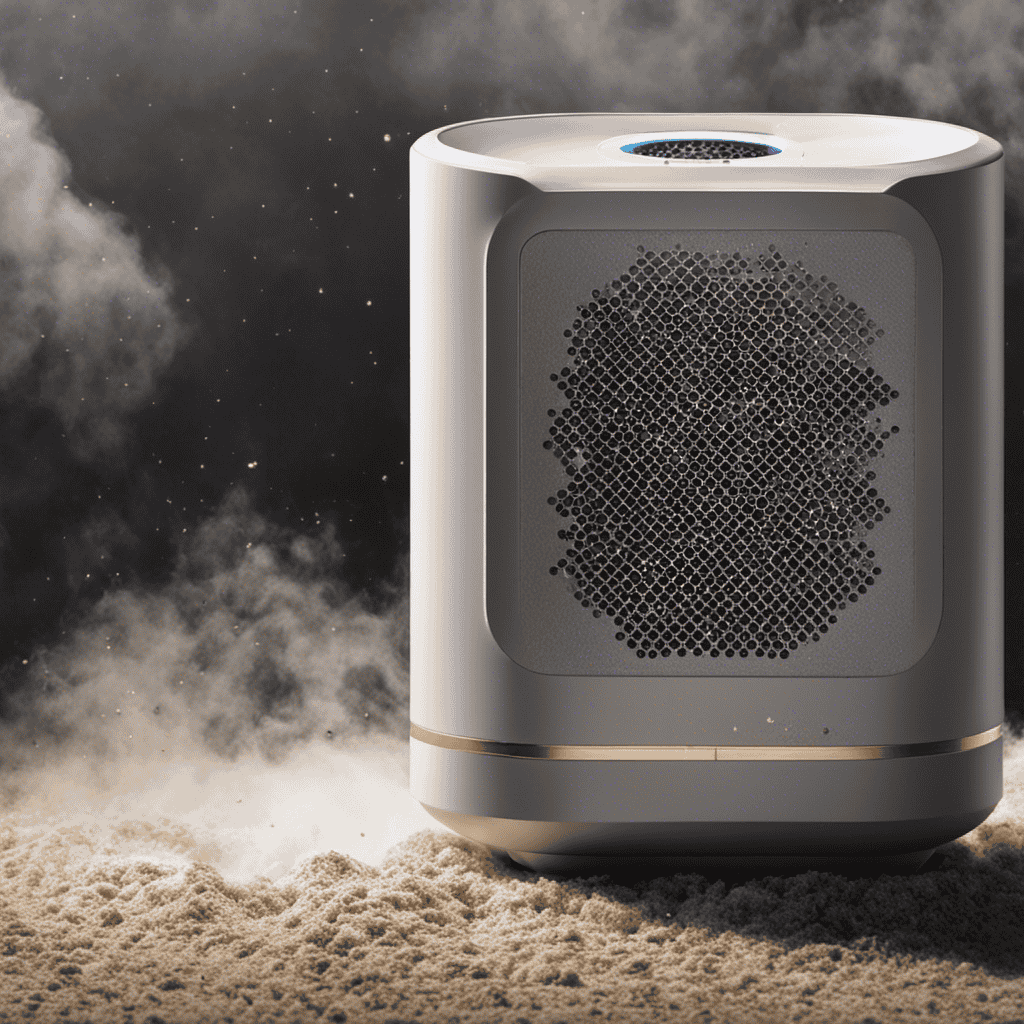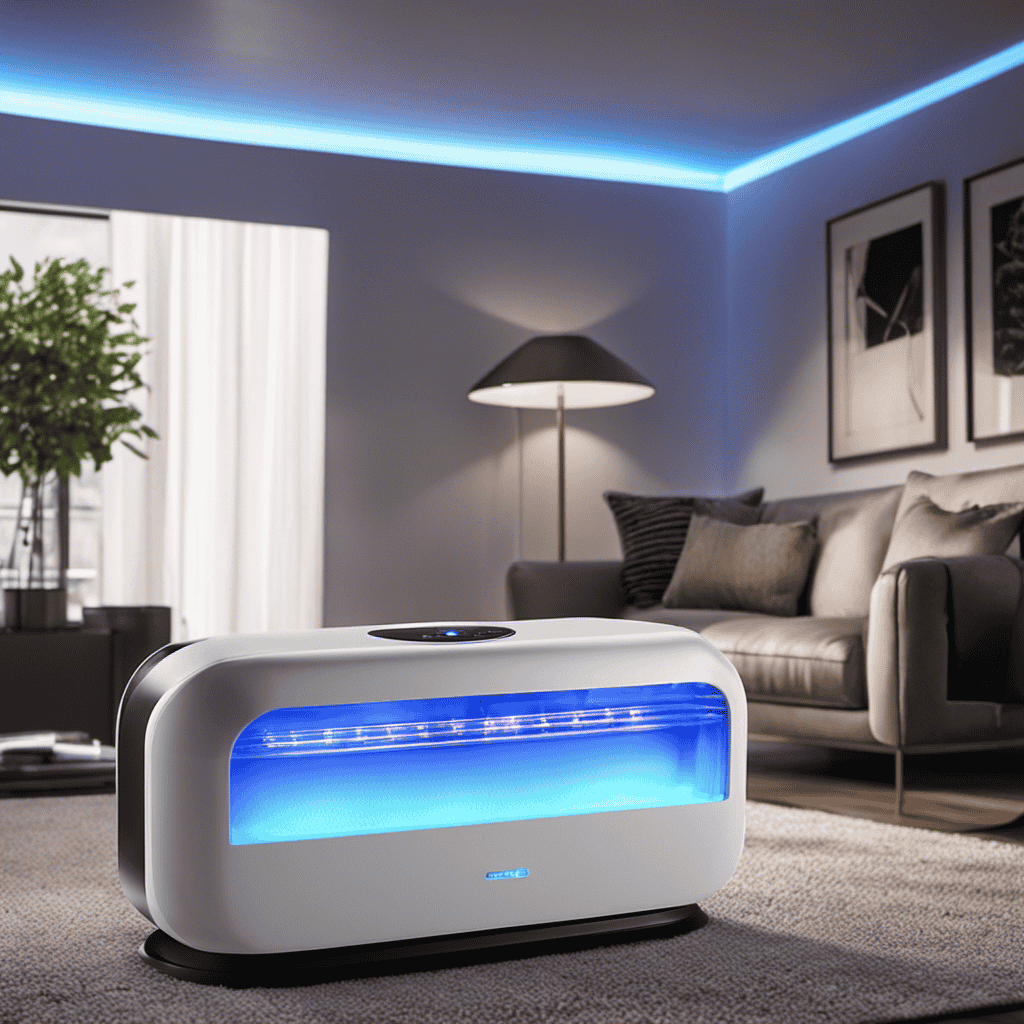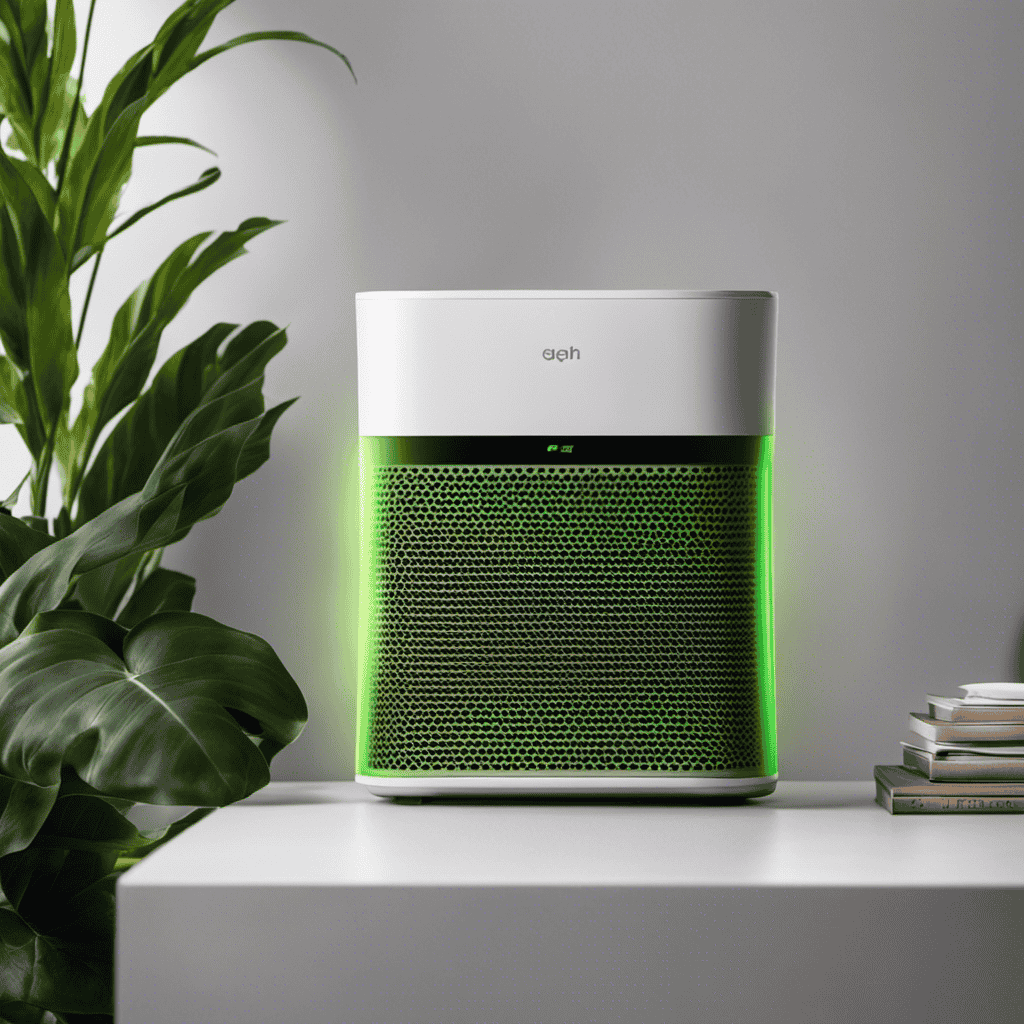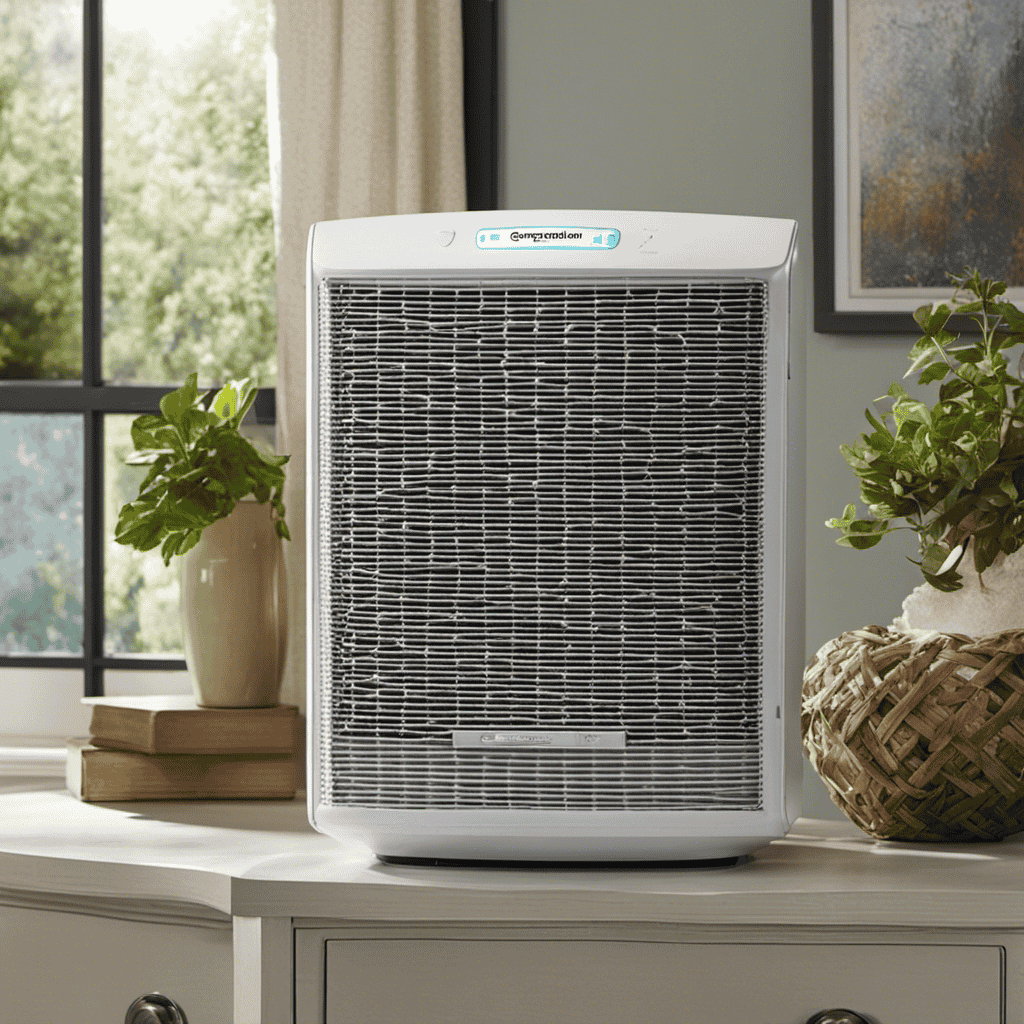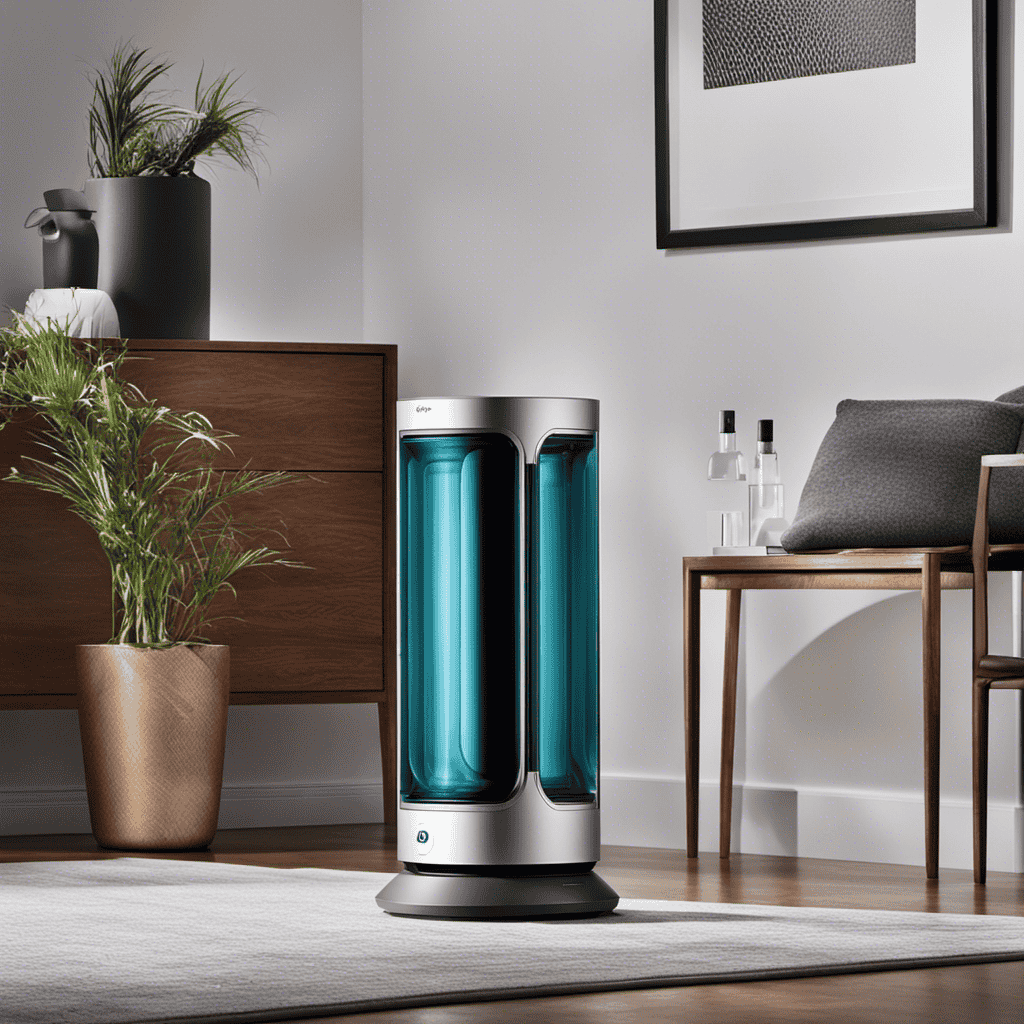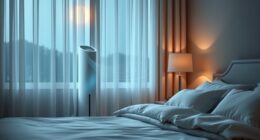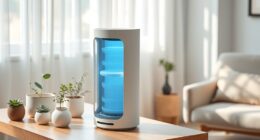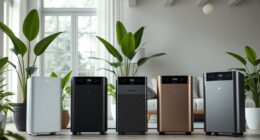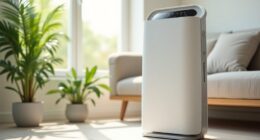Hey there!
So, you’ve got an air purifier, huh? Good on you for taking care of your indoor air quality. But here’s the thing – how do you know if it’s actually working?
Don’t worry, I’ve got you covered. In this article, I’ll walk you through some foolproof ways to determine if your air purifier is doing its job.
From checking the filters and noise levels to evaluating performance and allergen reduction, we’ll leave no stone unturned.
Let’s dive in and get to the bottom of this air purifier mystery!
Key Takeaways
- Regularly inspect and clean or replace filters for maximum effectiveness.
- Signs of a clogged filter include reduced airflow and a musty odor.
- Monitoring air quality levels using reliable indicators like air quality monitors helps identify the need for air purifier maintenance.
- Assess allergen reduction by monitoring allergen levels before and after using the air purifier.
Understanding Air Purifier Filters
To understand if your air purifier is working, you should check the condition of the filters.
Air purifiers use advanced technology to filter out pollutants and improve indoor air quality.
The filters play a crucial role in trapping harmful particles such as dust, pollen, pet dander, and smoke.
By removing these pollutants, air purifiers provide numerous benefits, including reducing allergies, improving respiratory health, and creating a cleaner living environment.
It’s important to regularly inspect and clean or replace the filters to ensure maximum effectiveness.
Over time, filters can become clogged with debris and lose their ability to capture pollutants.
Checking Air Purifier Noise Levels
Listen for any strange noises coming from your air purifier to determine if it is functioning properly. A noisy air purifier can be a sign of a malfunction or a clogged filter. It’s important to address these issues promptly to ensure the air purifier is effectively cleaning the air in your home. When it comes to air purifiers, energy consumption and sound levels are important factors to consider. To give you an idea of what to expect, here is a table outlining the energy consumption and sound levels of common air purifier types:
| Air Purifier Type | Energy Consumption (Watts) | Sound Levels (Decibels) |
|---|---|---|
| HEPA | 50-200 | 40-70 |
| Ionizer | 5-50 | 20-50 |
| UV-C | 20-60 | 30-60 |
Evaluating Air Purifier Performance
Evaluate the effectiveness of your air purifier by monitoring its noise levels and observing any changes in air quality.
When it comes to evaluating air purifier effectiveness, it’s important to compare different brands to find the one that suits your needs. Start by researching and reading reviews about various air purifiers available in the market. Look for features like the type of filters used, the Clean Air Delivery Rate (CADR), and the recommended room size. This information will help you compare different air purifiers and choose the one that matches your requirements.
Once you have selected an air purifier, monitor its noise levels during operation. A quiet air purifier is usually more desirable, as it won’t disturb your daily activities or sleep.
Additionally, observe any changes in air quality by paying attention to factors like improved air freshness, reduction in dust particles or odors, and a decrease in allergy or asthma symptoms.
Monitoring Air Quality Levels
When it comes to monitoring air quality levels, it’s important to have reliable indicators that can accurately measure the pollution in the air. These indicators can include devices such as air quality monitors or sensors that measure the levels of pollutants like PM2.5, VOCs, and carbon dioxide.
To ensure the effectiveness of air purification systems, it’s crucial to test their ability to remove pollutants from the air. This can be done by conducting before and after tests to measure the reduction in pollutant levels and comparing the results to established air quality guidelines.
Reliable Air Quality Indicators
There’s no surefire way to determine if your air purifier is working properly without reliable air quality indicators. These indicators, such as reliable air quality sensors, play a crucial role in evaluating the effectiveness of your air purifier.
With the help of these sensors, you can analyze the air purifier’s performance and ensure that it is efficiently removing pollutants from your indoor environment. Reliable air quality sensors provide real-time data on various air pollutants such as dust, pollen, smoke, and volatile organic compounds (VOCs).
Testing Air Purification Effectiveness
To determine the effectiveness of your air purifier, you can easily test its purification capabilities by using a reliable air quality sensor. This sensor will measure the level of pollutants in the air before and after running the air purifier.
Here are four key factors to consider when evaluating air purifier effectiveness and comparing air purifier performance:
-
Clean Air Delivery Rate (CADR): This measures the volume of clean air produced by the purifier in a specific amount of time. A higher CADR indicates a more efficient purifier.
-
Filter Efficiency: Look for purifiers with high-efficiency particulate air (HEPA) filters. These filters can capture particles as small as 0.3 microns, including dust, pollen, and pet dander.
-
Noise Level: Consider the noise produced by the purifier, especially if you plan to use it in your bedroom or office. Look for purifiers with noise levels below 50 decibels.
-
Energy Consumption: Check the energy consumption of the purifier to ensure it is energy-efficient and won’t significantly increase your electricity bill.
Assessing Allergen Reduction
You can determine if your air purifier is working by checking if the allergen levels have decreased. Assessing air purifier effectiveness is crucial to ensuring that it is efficiently cleaning the air in your home.
Start by monitoring the allergen levels before and after using the purifier. Use an air quality monitor or test kit to measure the concentration of common allergens like pollen, dust mites, and pet dander. Take note of the initial levels and compare them to the readings after using the air purifier for a significant period.
A significant decrease in allergen levels indicates that the purifier is effectively removing airborne particles. However, keep in mind that the efficiency of the air purifier can be affected by factors such as room size, filter quality, and maintenance.
Regularly assessing the allergen reduction will help you determine if your air purifier is functioning optimally.
Measuring Indoor Air Freshness
Maintaining a clean and fresh indoor environment is important. One way to measure the air freshness is by using a carbon dioxide monitor. This device detects and measures the levels of carbon dioxide in the air, which can be an indicator of air quality.
Here are some key points about measuring indoor air pollutants and using air quality sensors:
-
Carbon dioxide monitors: These devices can accurately measure the concentration of carbon dioxide in the air, helping you assess the freshness of indoor air.
-
Air quality sensors: These sensors are designed to detect various pollutants, such as volatile organic compounds (VOCs), particulate matter, and formaldehyde. They provide real-time data on the air quality in your home.
-
Importance of measuring air pollutants: Measuring air pollutants is crucial for identifying potential health risks and ensuring a safe and healthy indoor environment.
-
Monitoring air quality: Regularly monitoring air quality can help you identify any issues or sources of pollutants, allowing you to take appropriate actions to improve the air freshness in your home.
Analyzing Air Purifier Maintenance
When it comes to maintaining your air purifier, there are three key points to keep in mind: changing the filter regularly, monitoring air quality, and checking for malfunctions.
It’s important to change the filter regularly as a dirty filter can reduce the effectiveness of the purifier.
Additionally, monitoring the air quality will help you determine if the purifier is working properly and if any adjustments need to be made.
Lastly, checking for malfunctions ensures that the purifier is operating at its best and can help prevent any potential issues.
Change Filter Regularly
To ensure your air purifier is working effectively, make sure to regularly change the filter. Neglecting to change the filter can lead to a decrease in the air purifier’s performance and can even cause it to stop working altogether.
Here are some air purifier maintenance tips and signs of a clogged filter to keep in mind:
- Check the manufacturer’s instructions for how often to change the filter.
- Look for signs of a clogged filter, such as reduced airflow or a musty odor.
- Consider the air quality in your area and adjust the frequency of filter changes accordingly.
- Keep spare filters on hand to ensure you can replace them promptly.
Regularly changing the filter is crucial for keeping your air purifier functioning optimally and maintaining clean air in your space.
Now let’s move on to the next section and learn how to monitor air quality effectively.
Monitor Air Quality
You can easily monitor the air quality in your space by using an air quality monitor. This device measures various pollutants in the air and gives you real-time information about the air you breathe. It is an essential tool in maintaining good indoor air quality.
By regularly monitoring the air quality, you can identify any signs of poor indoor air quality, such as high levels of particulate matter, volatile organic compounds (VOCs), or elevated humidity. These signs may indicate the need for air purifier maintenance or other remedial actions to improve the air quality in your space.
Monitoring the air quality can help you take proactive steps to ensure a healthy and comfortable environment.
Now, let’s move on to the next section and check for any malfunctions in your air purifier.
Check for Malfunctions
Make sure to regularly check for any malfunctions in your air purifier to ensure it’s working effectively. Here are some important things to evaluate airflow efficiency and troubleshoot common issues:
-
Check the filters: Dirty or clogged filters can hinder airflow and reduce the purifier’s effectiveness. Clean or replace them according to the manufacturer’s instructions.
-
Inspect the fan: Ensure the fan is spinning properly and not making any unusual noises. A faulty fan can disrupt airflow and impact the purifier’s performance.
-
Monitor the sensor: Some air purifiers have sensors that detect air quality. Check if the sensor is clean and functioning correctly to ensure accurate readings.
-
Inspect the power cord: Make sure the power cord is securely connected and not damaged. A loose or damaged cord can result in intermittent power supply and affect the purifier’s operation.
Regularly checking for malfunctions and troubleshooting any issues will help maintain your air purifier’s efficiency and ensure it’s working optimally.
Verifying Air Purifier Efficiency
Check if your air purifier is functioning properly by looking for any visible signs of dust or particles in the air.
To verify the effectiveness of your air purifier, you can conduct a simple test. Place a sheet of white paper near the air purifier and let it run for a few hours. Afterward, examine the paper for any visible dust or particles that may have been captured. This will give you a good indication of how well your air purifier is performing.
Additionally, you can also assess the air quality in your space by using an air quality monitor. These devices can measure the levels of pollutants in the air, such as dust, pollen, and volatile organic compounds. By monitoring the air quality over time, you can determine if your air purifier is effectively removing these contaminants.
Frequently Asked Questions
How Long Does the Air Purifier Filter Typically Last Before It Needs to Be Replaced?
The air purifier filter typically lasts for a certain period of time before it needs to be replaced. Signs of a clogged filter are reduced airflow and decreased performance in air purifier maintenance.
Can an Air Purifier Eliminate All Types of Allergens, Including Pet Dander and Pollen?
An air purifier can effectively eliminate pet dander and pollen, making it beneficial for those with allergies. It filters out allergens from the air, providing relief from pet allergies and seasonal allergies.
Is It Normal for an Air Purifier to Emit a Slight Odor When It Is Running?
Yes, it’s normal for an air purifier to emit a slight odor when running. However, if the odor is strong or unpleasant, it may indicate a problem with the purification system.
How Can I Determine the Ideal Location to Place My Air Purifier for Maximum Effectiveness?
To determine the ideal placement of my air purifier for maximum effectiveness, I need to consider factors such as the size of the room, airflow patterns, and the presence of obstacles.
Are There Any Potential Health Risks Associated With Using an Air Purifier for an Extended Period of Time?
There may be potential side effects associated with using an air purifier for an extended period of time, such as dryness or irritation of the eyes, throat, or skin. It is important to consider the long-term effects and consult with a healthcare professional if necessary.
How Can I Tell if My Honeywell Hepa Air Purifier 50150 Is Working Properly?
If you want to check if your Honeywell HEPA air purifier 50150 is working properly, start by checking the honeywell hepa air purifier fuse. Make sure the fuse is not damaged or blown. Additionally, monitor the air quality in your home to ensure the purifier is effectively filtering out pollutants.
Conclusion
In conclusion, it is crucial to keep tabs on your air purifier’s performance for maintaining a healthy indoor environment. Regularly checking its filters, noise levels, and overall efficiency ensures effective reduction of allergens and improved air quality. Monitoring air freshness and conducting regular maintenance guarantees optimal performance.
Imagine a home where clean, fresh air fills the room, free from pollutants and allergens. With a well-functioning air purifier, this image can become a reality, creating a haven of pure, refreshing air for you and your loved ones.
